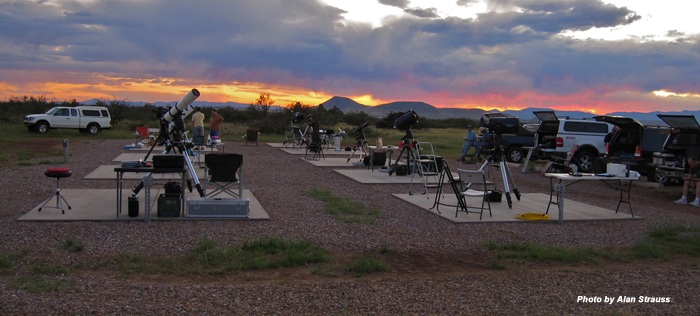A Facility of the Tucson Amateur Astronomy Association
by Bill Lofquist
At the June 2007 meeting of the Board of Directors of the Tucson Amateur Astronomy Association (TAAA), two goals were set related to a long-time desire of its members. These were: by May 2008 (1) land will be secured for a permanent dark observing site and (2) a strategic plan will be in place for its development. The TAAA, which was organized in 1954, had for several decades searched for land for this purpose.
With the setting of these goals, steps were immediately taken to achieve them. Members were invited to submit proposals for land. A piece of former ranch land in the Turkey Creek area west of the Chiricahua Mountains in Cochise County was found and evaluated. While the land search continued, four TAAA members organized themselves as the Perseus Group to purchase land in order to make a gift of it to the club. These members were Sam Rua, Robert Crawford, Erich Karkoschka and John and Liz Kalas. In August 2007, a special meeting of about 40 members was held to engage those interested in creating a vision for a new astronomy complex. Subsequent small group meetings were held to make this vision very specific.
The land was purchased in October 2007, and the vision was shaped into an application to the Cochise County Planning and Zoning Commission for a Special Use Permit. This application was unanimously approved in February 2008 and the development of the Chiricahua Astronomy Complex (CAC) was set in motion. Sixteen acres of land was donated to the club by the Perseus Group.
The first phase of development, the infrastructure that was needed, was begun later that year. This included the improvement and building of roads, the extension of electric service to the site, the drilling of a well and building the well house, the construction of bathroom facilities with septic system, and the creation of a graveled parking area. This initial work was completed in early 2010. On February 13th, the first star party was held and members started using the site for observing.
The next phase of development (2a) included the “public area” adjacent to the parking area. This provided ten concrete observing pads with electric service (see picture below), the building of a roll-off roof observatory for a 14” SCT telescope, two secure steel storage units, and a large circular concrete observing pad for an 18” Dobsonian telescope. Four RV/Camper sites were included in the later phase (2b). During this time, a TAAA member made a generous gift of four telescopes with accessories to use at CAC, which included the 14” SCT telescope. These developments were completed in September 2011 (phase 2a) and September 2012 (phase 2b).

Other components of the Master Site Plan (MSP) to be developed in the future include an Outdoor Education Ramada, twelve Sleeping Rooms, an Education/Activity Center, a Residence, one or two Large Roll-off Roof Observatories, 45 Member Pads and 15 Member Observatories. See the MSP for these facilities. While this is a long-range endeavor, the goal of completing the Master Site Plan is being aggressively pursued by the TAAA membership.
Members of the TAAA have provided all of the funds needed to bring us this far in the development of CAC. To move ahead we will need help from additional resources such as private and corporate foundations, grants and contributions from individuals.

